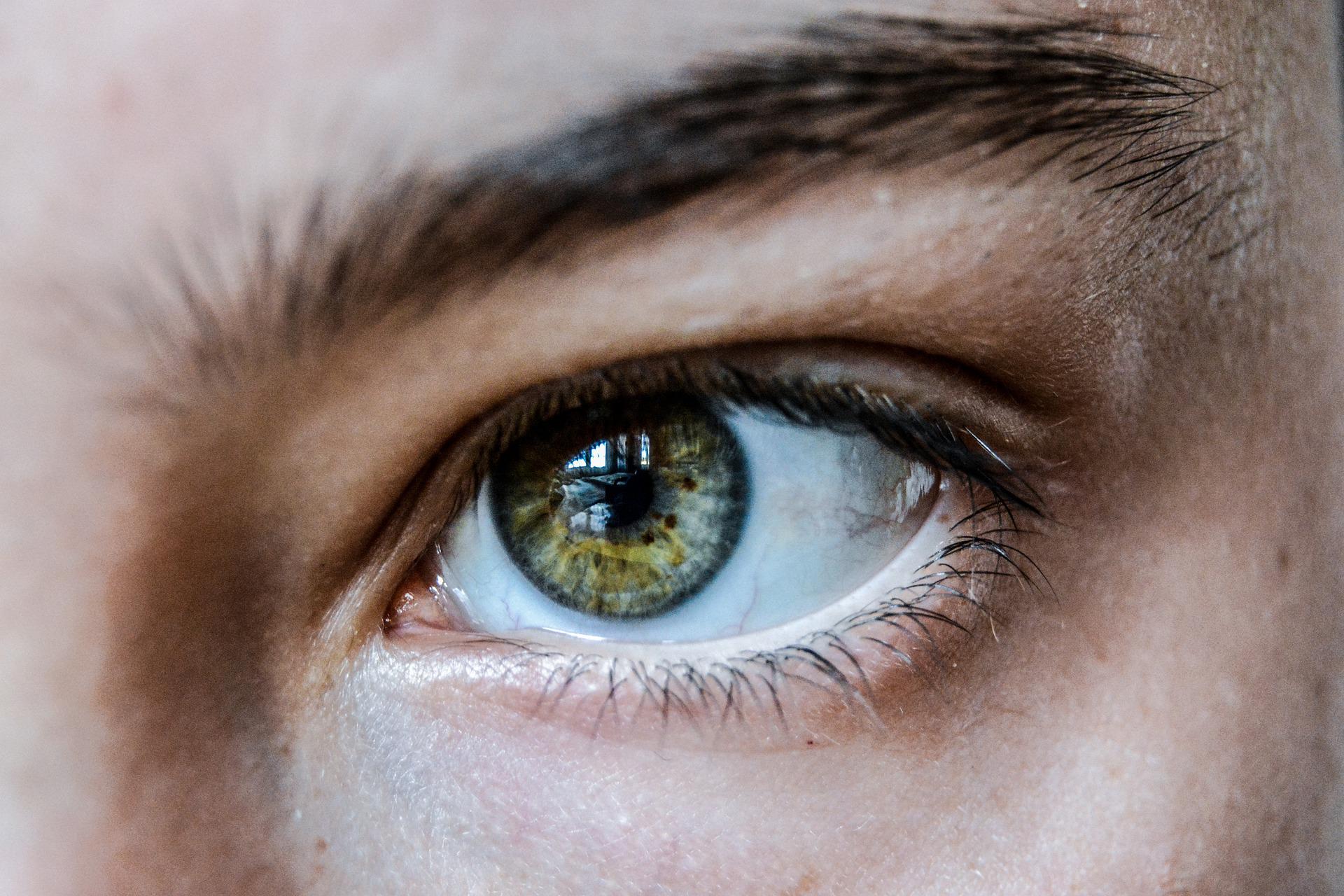
In diabetics, blurred or double vision is one of the signs of abnormally high (hyperglycemia) or low (hypoglycemia) blood sugar levels. But it can also be a symptom of other eye conditions, some of which can lead to blindness. What are the most common eye conditions in people with diabetes? How are they detected and treated? In this article, you will learn about the main diseases that affect:
- the retina (in the case of diabetic retinopathy)
- the optic nerve (with glaucoma),
- and finally, the lens (cataract).
Diabetic retinopathy
The disease
In its inner part, the surface of the eyeball is lined by a very thin tissue: the retina. The retina is equipped with light-sensitive sensors, whose job is to convert light into nerve impulses. When the vessels in this membrane become blocked, microaneurysms and small haemorrhages occur. This is called retinopathy. It is the most common eye disease in diabetics. As a matter of fact, its main risk factors are:
- hyperglycemia,
- long-term diabetes,
- and high blood pressure, which affects many diabetic patients.
Its symptoms
At first, retinopathy is asymptomatic. Then pain appears, as well as the impression that a veil covers the eye, affecting the quality of vision. There are two forms of this condition:
- a non-proliferative form, characterized by rounded lesions sometimes followed by hemorrhages,
- and a more severe proliferative form, characterized by bleeding in the vitreous cavity and even damage to the optic nerve.
Its complications
The most acute forms of retinopathy lead to (partial or total) visual impairment, tears in the retina and retinal detachment. There is also a risk of cataract, which is 26% higher for a diabetic patient with retinopathy. In some patients, diabetic macular oedema may develop. This means that the macula (located in the center of the retina) swells due to an influx of intraretinal fluid and central vision becomes blurred. People with diabetes who have such an oedema have a 59% higher risk of developing a cataract than people without diabetes.
Its diagnosis
All types of retinal damage (including diabetic retinopathy) can be detected by means of a fundus examination. This painless procedure involves the ophthalmologist observing the part of the eye behind the crystalline lens. It requires prior dilation of the pupils with an eye drop and can be performed:
- with a light beam biomicroscope,
- or with a binocular ophthalmoscope equipped with a convergent lens.
In both cases, the procedure only takes a few minutes once the pupils are sufficiently dilated.
Its treatment
The way diabetic retinopathy is treated varies according to how advanced the disease is. A series of corticosteroid or anti-VEGF (anti-vascular endothelial growth factor) injections may be sufficient to cure it after an early diagnosis. The benefit of anti-VEGF medication is twofold. This treatment is likely to:
- stop the proliferation of blood vessels, which renew themselves uncontrollably on the surface of the retina,
- and stabilize visual acuity.
The chances of success of anti-VEGF injections are greater if the patient stops smoking, has regular medical supervision, and has their blood sugar levels well under control.
Laser treatment is permanent in many cases. Finally, for the most serious forms, surgery is necessary.
Glaucoma
The disease
The optic nerve, which transmits images to the brain, plays a key role in human vision. It is connected to the retina by very sensitive nerve endings. In the event of intraocular hypertension (i.e., when the pressure in the eye increases), these connections become damaged, and lesions appear on the nerve. This is called glaucoma. The term “glaucoma” refers to a group of diseases related to the increase in pressure of the liquids inside the eye. This can have several causes such as:
- a bad evacuation of the aqueous humor,
- a shock to the eyeball (e.g., during sports),
- or eye surgery.
Type 2 diabetes is one of the main risk factors for glaucoma, along with high blood pressure, myopia, sleep apnea and age. In addition, a 2020 meta-analysis showed that diabetics are more prone to ocular hypertension, which almost always leads to glaucoma.
Its symptoms
Glaucoma can cause moderate to severe pain and impaired vision. In the early stages of the disease, blind spots occur in the field of vision. This may be intermittent, with vision returning to normal and then the spots returning later.
Its complications
From a certain level of damage to the optic nerve, glaucoma can reduce the field of vision: objects at the edge of the field of vision appear blurred and driving motor vehicles becomes dangerous. If the disease is not treated, there is a risk of total vision loss. Indeed, glaucoma is the second leading cause of blindness worldwide, behind cataracts.
Its diagnosis
The detection of glaucoma is possible thanks to several medical techniques such as:
- gonioscopy, which makes it possible to observe the flow of aqueous humour,
- tonometry, which consists of measuring the intraocular pressure,
- the fundus, during which the optic nerve is examined,
- and above all the analysis of the visual field.
This last examination is an important step in the diagnosis of glaucoma. On this occasion, all the visual fibers of the optic nerve are tested and a precise mapping of the field of vision is established.
Its treatment
The damage caused to the optic nerve by severe glaucoma is unfortunately irreversible. That being said, if the disease is caught early enough, the administration of an eye drop can reduce the amount of aqueous humour in the eyeball. Laser treatment can also help to slow down the disease’s progression.
Cataract
The disease
At the front of the eye, just behind the iris, is a thick translucent lens: the crystalline lens, which is 4 millimeters thick. Its role is to focus and ensure sharpness of vision. To do this, the crystalline lens focuses the light rays towards the retina. However, sometimes this organ can become opaque, hindering the path of light towards the membrane. This is called a cataract. Compared to the general population, people with diabetes are 60% more likely to be affected by this disease.
Its symptoms
Compared to most other eye diseases, cataracts are painless and develop very gradually. The symptoms of cataract are blurred vision, difficulty in reading, altered perception of contrasts or increased sensitivity to light. Sometimes dots or spots appear in the patient’s field of vision.
Its complications
In the long term, cataracts lead to a significant reduction in vision. If the lens is completely opaque, vision disappears completely. Cataracts are currently the leading cause of blindness in the world for people aged 50 and over.
Its diagnosis
According to a British study conducted between 2000 and 2015 on a cohort of more than 56,500 individuals, diabetes doubles the risk of developing a cataract. It is therefore essential for diabetic patients to consult a specialist on a regular basis to catch this disease in its early stages. Cataracts are diagnosed using a medical instrument, the ophthalmoscope (or funduscope), which allows the doctor to observe the crystalline lens.
Its treatment
If the cataract is mild, the loss of visual acuity can be compensated for by wearing glasses and under strict medical supervision. When the disease worsens, glasses are no longer sufficient and fundus examinations become impossible. In this case, surgery may be necessary. This operation consists of replacing the opacified lens with an implant: an artificial crystalline lens.
Sources:
- https://pubmed.ncbi.nlm.nih.gov/33940045/
- https://www.nhs.uk/conditions/diabetic-retinopathy/#:~:text=Diabetic%20retinopathy%20is%20a%20complication,it%20could%20threaten%20your%20sight
- http://www.diabeticretinopathy.org.uk/proliferative.html
- https://www.diabetes.co.uk/diabetes-complications/diabetic-maculopathy.html)
- https://www.nature.com/articles/s41433-017-0003-1#:~:text=According%20to%20our%20study%2C%20diabetes,patients%20with%20long%2Dstanding%20diabetes
- https://www.medecinesciences.org/en/articles/medsci/full_html/2009/12/medsci20092512p1105/medsci20092512p1105.html
- http://www.diabeticretinopathy.org.uk/drugtreatment.htm
- https://www.ncbi.nlm.nih.gov/pmc/articles/PMC7141380/#__ffn_sectitle
- https://pubmed.ncbi.nlm.nih.gov/15154948/
- https://www.thelancet.com/journals/langlo/article/PIIS2214-109X(20)30489-7/fulltext
- https://www.diabetes.co.uk/diabetes-complications/cataracts.html
- https://www.thelancet.com/journals/langlo/article/PIIS2214-109X(20)30489-7/fulltext
- https://www.nature.com/articles/s41433-017-0003-1#ref-CR1
Our latest publications
Want to learn more about topics related to blood sugar management?
Here are our most recent blog posts!



